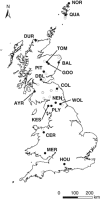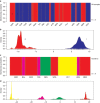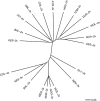Hybridisation and genetic diversity in introduced Mimulus (Phrymaceae)
- PMID: 23169562
- PMCID: PMC3554457
- DOI: 10.1038/hdy.2012.91
Hybridisation and genetic diversity in introduced Mimulus (Phrymaceae)
Abstract
Hybridisation among taxa with different ploidy levels is often associated with hybrid sterility. Clonal reproduction can stabilise these hybrids, but pervasive clonality may have a profound impact on the distribution of genetic diversity in natural populations. Here we investigate a widespread triploid taxon resulting from hybridisation between diploid Mimulus guttatus and tetraploid Mimulus luteus, two species that were introduced into the United Kingdom (UK) in the nineteenth century. This hybrid, Mimulus x robertsii, is largely sterile but capable of prolific vegetative propagation and has been recorded in the wild since 1872. We surveyed 40 Mimulus populations from localities across the UK to examine the current incidence of hybrids, and selected seventeen populations for genetic analysis using codominant markers. Cluster analyses revealed two main groups of genetically distinct individuals, corresponding to either diploid (M. guttatus) or polyploid (M. luteus and M. x robertsii) samples. Triploid hybrids were found in around 50% of sampled sites, sometimes coexisting with one of the parental species (M. guttatus). The other parent, M. luteus, was restricted to a single locality. Individual populations of M. x robertsii were genetically variable, containing multiple, highly heterozygous clones, with the majority of genetic variation distributed among- rather than within populations. Our findings demonstrate that this largely sterile, clonal taxon can preserve non-negligible amounts of genetic variation. The presence of genetically variable hybrid populations may provide the material for the continued success of asexual taxa in diverse environments.
Figures




Similar articles
-
Strongly asymmetric hybridization barriers shape the origin of a new polyploid species and its hybrid ancestor.Am J Bot. 2016 Jul;103(7):1272-88. doi: 10.3732/ajb.1500471. Epub 2016 May 24. Am J Bot. 2016. PMID: 27221281
-
Rapid local adaptation in both sexual and asexual invasive populations of monkeyflowers (Mimulus spp.).Ann Bot. 2021 Apr 17;127(5):655-668. doi: 10.1093/aob/mcab004. Ann Bot. 2021. PMID: 33604608 Free PMC article.
-
Mimulus peregrinus (Phrymaceae): A new British allopolyploid species.PhytoKeys. 2012;(14):1-14. doi: 10.3897/phytokeys.14.3305. Epub 2012 Jul 6. PhytoKeys. 2012. PMID: 23170069 Free PMC article.
-
Speciation by genome duplication: Repeated origins and genomic composition of the recently formed allopolyploid species Mimulus peregrinus.Evolution. 2015 Jun;69(6):1487-1500. doi: 10.1111/evo.12678. Epub 2015 May 27. Evolution. 2015. PMID: 25929999 Free PMC article.
-
Distant hybridization leads to different ploidy fishes.Sci China Life Sci. 2010 Apr;53(4):416-25. doi: 10.1007/s11427-010-0057-9. Epub 2010 May 7. Sci China Life Sci. 2010. PMID: 20596907 Review.
Cited by
-
Genetic diversity and population structure among native, naturalized, and invasive populations of the common yellow monkeyflower, Mimulus guttatus (Phrymaceae).Ecol Evol. 2023 Apr 7;13(4):e9596. doi: 10.1002/ece3.9596. eCollection 2023 Apr. Ecol Evol. 2023. PMID: 37038527 Free PMC article.
-
Natural neopolyploids: a stimulus for novel research.New Phytol. 2025 Apr;246(1):78-93. doi: 10.1111/nph.20437. Epub 2025 Feb 14. New Phytol. 2025. PMID: 39953679 Free PMC article. Review.
-
Population genomic and historical analysis suggests a global invasion by bridgehead processes in Mimulus guttatus.Commun Biol. 2021 Mar 12;4(1):327. doi: 10.1038/s42003-021-01795-x. Commun Biol. 2021. PMID: 33712659 Free PMC article.
-
High genetic diversity and distinctiveness of rear-edge climate relicts maintained by ancient tetraploidisation for Alnus glutinosa.PLoS One. 2013 Sep 30;8(9):e75029. doi: 10.1371/journal.pone.0075029. eCollection 2013. PLoS One. 2013. PMID: 24098677 Free PMC article.
-
Nineteenth century French rose (Rosa sp.) germplasm shows a shift over time from a European to an Asian genetic background.J Exp Bot. 2016 Aug;67(15):4711-25. doi: 10.1093/jxb/erw269. Epub 2016 Jul 12. J Exp Bot. 2016. PMID: 27406785 Free PMC article.
References
-
- Abbott RJ. Plant invasions, interspecific hybridization and the evolution of new plant taxa. Trends Ecol Evol. 1992;7:401–405. - PubMed
-
- Abbott RJ, Brennan AC, James JK, Forbes DG, Hegarty MJ, Hiscock SJ. Recent hybrid origin and invasion of the British Isles by a self-incompatible species, Oxford ragwort (Senecio squalidus L., Asteraceae) Biol Invasions. 2009;11:1145–1158.
-
- Alberto F. MsatAllele_1.0: an R package to visualize the binning of microsatellite alleles. J Hered. 2009;100:394–397. - PubMed
-
- Arnaud-Haond S, Duarte CM, Alberto F, Serrao EA. Standardizing methods to address clonality in population studies. Molecular Ecology. 2007;16:5115–5139. - PubMed
Publication types
MeSH terms
Substances
LinkOut - more resources
Full Text Sources
Other Literature Sources

